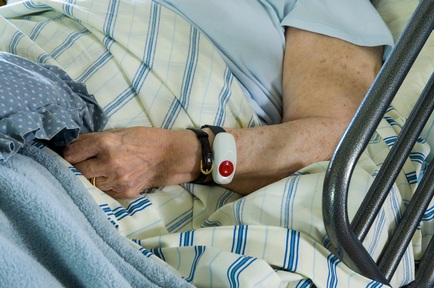Who's afraid of the big bad care wolf? Everybody it seems
Is Granny safe in her bed when social care’s about? Or must loved ones don red cloaks like Little Red Riding Hood and vigilantly keep watch over her?
![]() Is Granny safe from the social care wolf?
Is Granny safe from the social care wolf?
The fairy tale gone wrong
The inescapable fact is that the social care sector has a major ‘big, black wolf’ of an image problem with care staff and their bosses depicted as ready to prey on your innocent granny as she sits helpless and vulnerable in her bed.
This damning caricature is immortalised in red flag-waving headlines dominating the news. News of care workers who’ve abused the trust of people needing care are interspersed with family members’ scary experiences played out in the nation’s TV studios and airwaves.
While no one can hide under the bed blankets when the facts of real-life horror stories exist, how can a fine balance be struck to make others see the pleasures of care and not just the pain?
Here’s what people from the sector at a recent care conference had to say…
Training, ... TICK, innovation… TICK, personalised care… TICK… blah blah …ahh!... but have you got great leadership too?
The tips and tricks for excellence flew round the hall and were positively bouncing off the walls of the recent Care and Dementia Show where care workers, care home managers and others milled around looking for answers.
‘Don’t let anyone make you stray’
‘Find your niche and don’t let anyone make you stray from it’, that’s one of the gems dug up for people by Ernie Graham, chief executive at care provider Graham Care. “The problem with a lot of care providers is they are all one-size-fits-all”, he adds. But even if you have a niche, can you sell the idea to staff and can you motivate them enough to make them stay to shape your vision? What, with high staff turnover an issue for the social care sector?
As said by Graham Stokes, Bupa’s global director of dementia care (whose conference session ‘Living a better life with dementia’ put derrières on seats leaving standing room only) ... “Care staff are undervalued, underpaid, over-regulated and are caring for vulnerable people who don’t think they are vulnerable.
“We should respect care workers hugely.
“I couldn’t do it. Imagine giving personalised care to someone who would rather fight you than be undressed.”
Faced with such challenges, if care staff are having any confidence issues, they can’t rely on getting much ‘love’ back from a society fearful of being a victim in care.
![]() Britain’s retired mums and dads look to the Care Quality Commission to be their woodcutter
Britain’s retired mums and dads look to the Care Quality Commission to be their woodcutter
Elderly’s desperate search for a woodcutter
“People still don’t favour life in a care home”, Graham Stokes admits.
Living and dying in one’s own home seems to be a far greater aspiration for people than moving into a care home. Many would rather hold out for as long as they can or get sick trying to tend to themselves or others, rather than turn to a care home for help. And Britain’s retired look to the Care Quality Commission (CQC) to be their woodcutter, if they face difficulties with care.
The Good News
But while poorly performing care homes are rightly cut down to size by the regulator, the CQC in its State of Care 2015/16 report has spoken out about the need for the state to pay up now for social care or it will put the quality and sustainability of the sector at risk. And despite this financial strain and negative perceptions of care entrenched in the public’s consciousness, the CQC has seen standards in care homes rise over the years.
As of 31 July 2016, the social care services rated Good by the CQC include 73 per cent of (9,100) residential homes, 76 per cent of home care agencies (3,587) and 58 per cent of nursing homes (3,649).
In light of such figures, some argue the sector needs a rebrand. Should the word ‘care’ itself be ditched for its connotations of children being neglected upon entering ‘care’? One female nurse offered up this suggestion at the Care & Dementia Show. But as well as giving excellent care, is there another way to let the sector’s gentler side be seen?
Make some noise
“By helping people join in and be part of the community. There’s some fantastic success stories there about the ways people’s lives have been transformed”, says Vic Raynor, chief executive at the National Care Forum.
Whether it be schoolchildren coming to visit people in care homes, getting residents out to continue hobbies with friends or bringing members of the community into care settings to join in activities all year round- strong community links sends a strong message about a care home.
Sara McKee, a former chief operating officer at Anchor, who established care group Market Innovation, Evermore, is an advocate of getting out in the community and shouting about the merits of one’s care services by chatting to people in a coffee shop or even giving out flyers at the local community centre. So why not go out loud and proud banging the drum for social care?
Referring to social care's life-affirming attributes, Nadra Ahmed, chief executive of the National Care Association, is clear: “We have to believe in the image of our own sector.”
Not sexy enough? So challenge perceptions
It is not just the nation’s general population who need their perceptions challenged. Vic Raynor believes the positives of working in social care should be promoted to nurses too.
One university lecturer teaching nurses told carehome.co.uk at a Royal College of Nursing and British Geriatric Society conference in April that practising their profession in a care home is considered by many of her student nurses to be ‘less sexy’ than hospital work.
While perceived as far less dynamic, varied and exciting as work in a hospital, nurses working in social care also may not get the same access to training opportunities and pensions that the NHS can provide to nurses in hospital. However, Ms Raynor stresses the hidden pluses must be promoted to nurses: “Nurses are working in a completely person-centred agenda and you are able to create a package of nursing support around individuals in a way that you may not be able to do in a hospital.”
Nadra Ahmed agrees. “In the past, social care was a stepping stone for nursing. We need to make more of that.”
Something that is boosting the sector and staff morale is charitable acts. Care workers are trying dare devil stunts to raise money for good causes such as dementia research. The sight of nervous staff leaping out of aeroplanes to tandem skydive their way back to earth, would see some PR seeds of selfless good care sown.
’Care is more meaningful than stacking shelves’
To young people taking their first steps into the world of work, Nadra Ahmed has an upbeat message. “Why would you not want to work in social care?
“It gives you life skills. Caring for someone can be much more meaningful than stacking shelves.”
Ms McKee adds: “The hospitality sector has some really great people, everything else we can teach you.”
Care homes are already harnessing social media to get out the good news to people through Twitter, dedicated Facebook pages and the social care networking site Storii to let residents’ families know about the good care given.
![]() Should residents 'bang the drum' for their care home?
Should residents 'bang the drum' for their care home?
Stories for the Old
If staff can let residents ‘talk the talk’ for them even better. If a young person can reach an audience of thousands and even millions from their bedroom as they promote a new lipstick to their peers, why can’t a resident get on YouTube to vlog what they love about their care home?
'Just look at what a great time he’s having' they'll say as he shares a joke with friends at the care home or green-fingered tips while marvelling at veg grown at his gardening club. 'Check out my new hairdo', she’ll say, at her in-house hairdressers.
Little Red Riding Hood written by the Brothers Grimm it isn’t. Sharing such experiences online, may not appeal to everyone but a good story may bring some cheer to older people used to digesting a 'Grimm' book at bedtime.
Latest News Analysis
 04-Sep-19
Extra £1.5 billion announced for social care in Chancellor's Spending Review
04-Sep-19
Extra £1.5 billion announced for social care in Chancellor's Spending Review
 02-Jul-19
Department of Health forced to rethink care homes' nursing rates after legal challenge
02-Jul-19
Department of Health forced to rethink care homes' nursing rates after legal challenge
 18-Jun-19
Overnight care workers forced to sleep in offices and told 'bring your own bedding'
18-Jun-19
Overnight care workers forced to sleep in offices and told 'bring your own bedding'
 14-Jun-19
Back in the closet: Third of care home staff have had no LGBT+ awareness training
14-Jun-19
Back in the closet: Third of care home staff have had no LGBT+ awareness training
 11-Jun-19
PM candidates on social care: Rory Stewart calls fixing care an 'unfinished revolution'
11-Jun-19
PM candidates on social care: Rory Stewart calls fixing care an 'unfinished revolution'